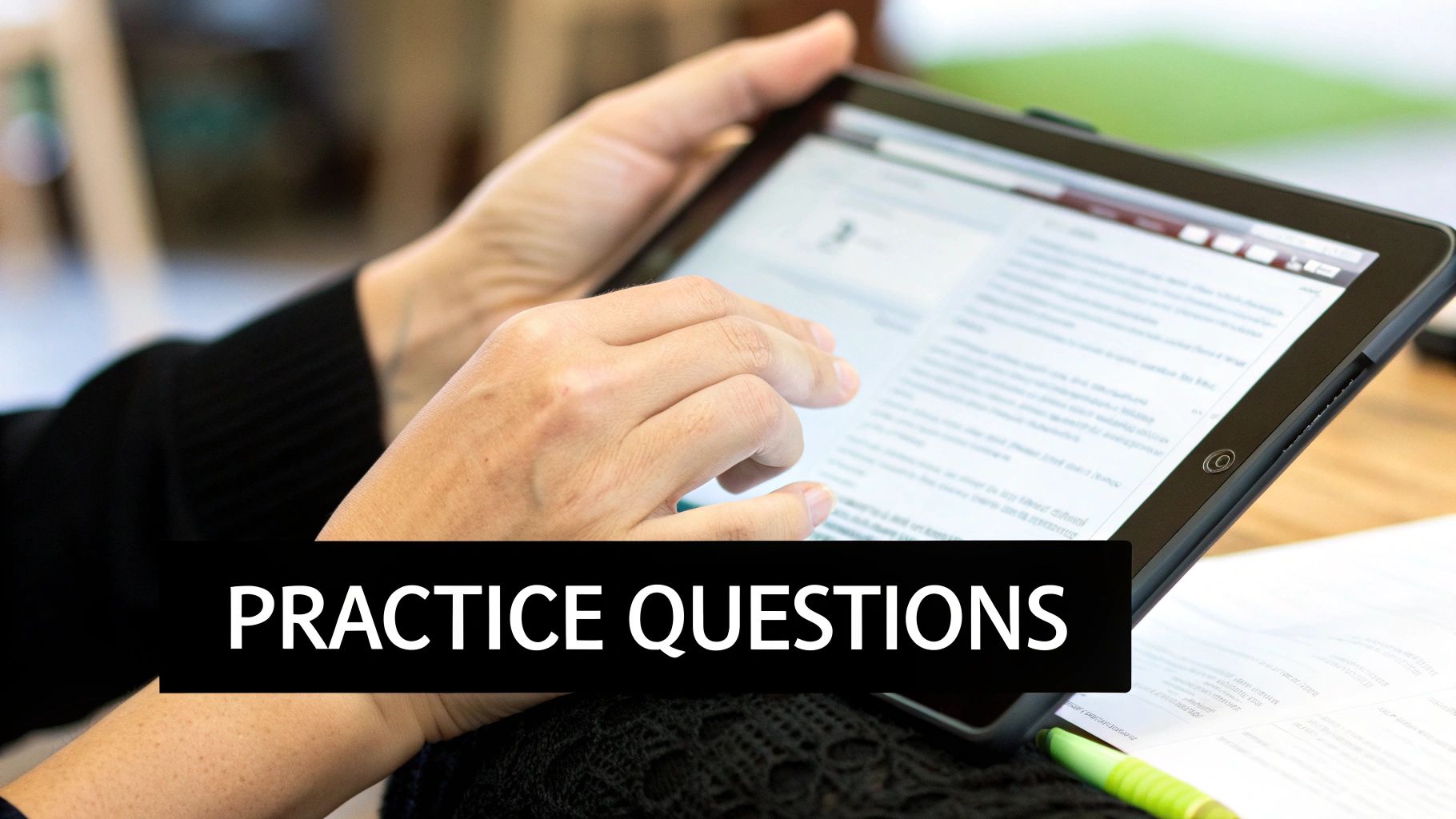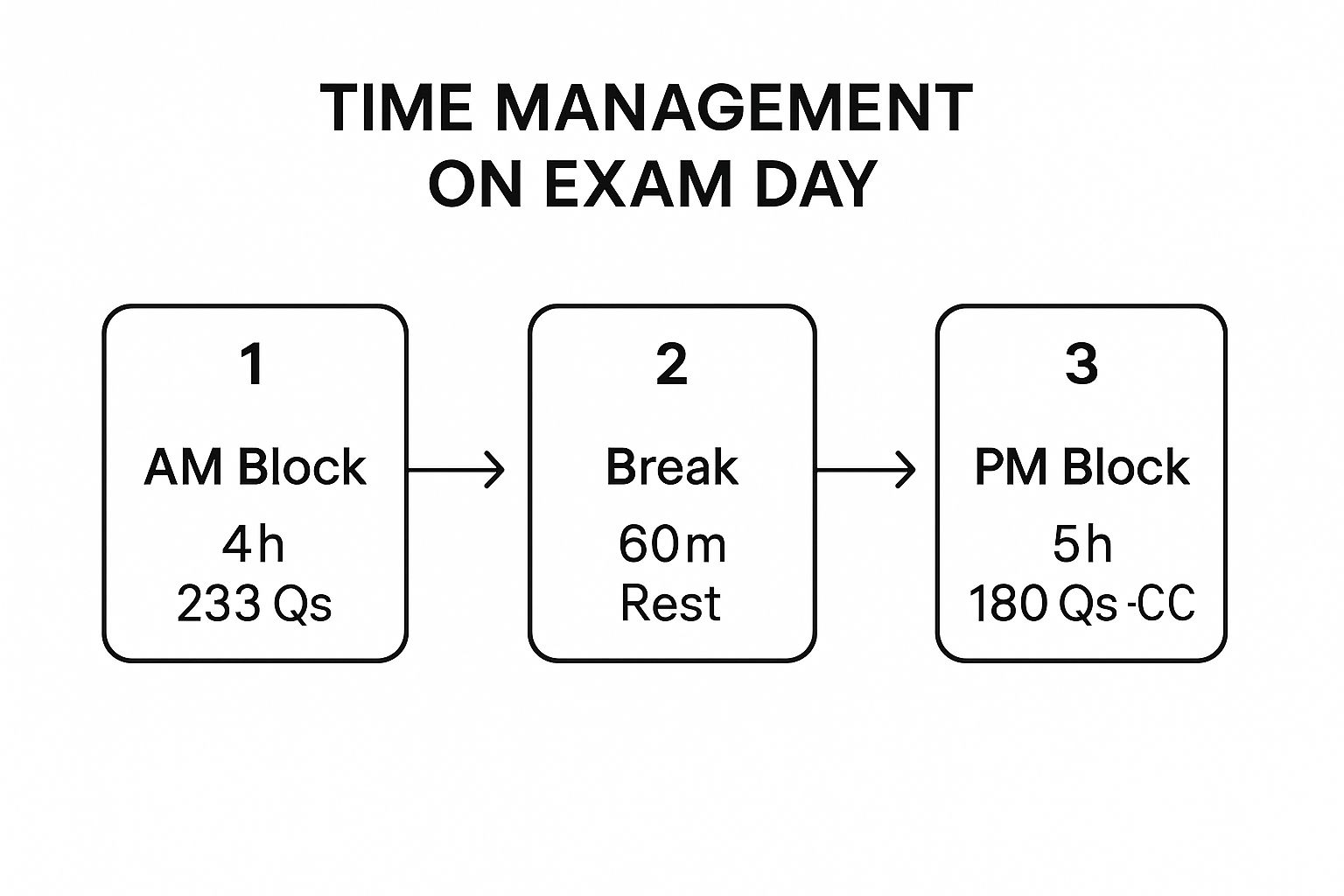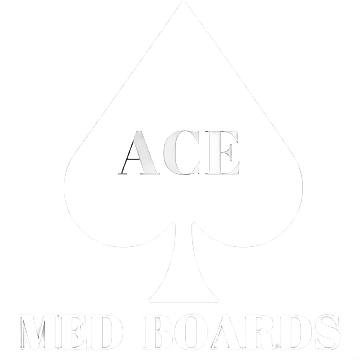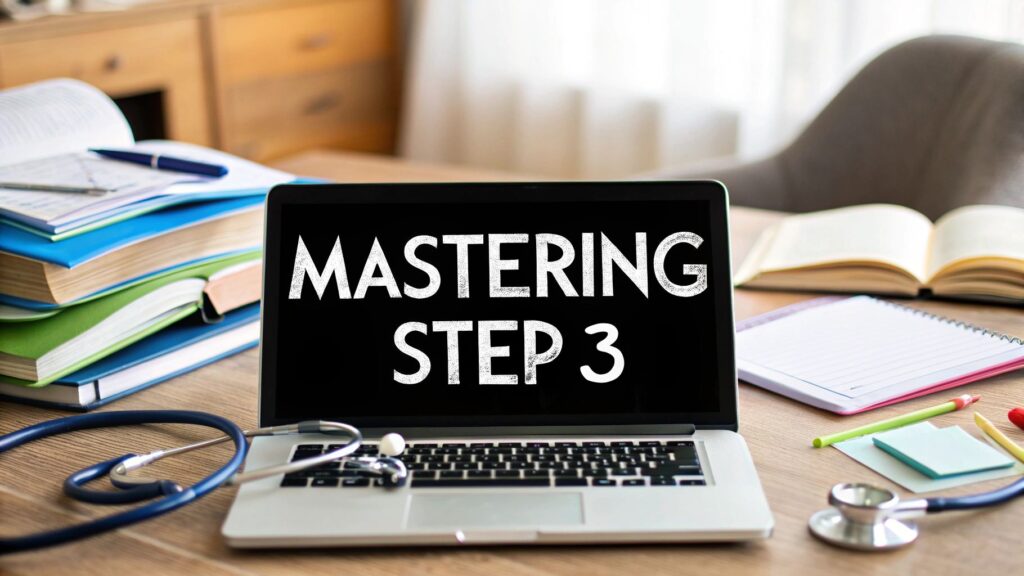So, you’re staring down the barrel of the USMLE Step 3. Before you can even think about a study plan, you have to know what you’re up against. This isn’t just Step 1 or 2 CK all over again—it’s a completely different beast.
Step 3 is the final checkpoint before you can practice medicine independently. The entire exam is designed to see if you can safely manage patients on your own, shifting the focus from memorizing facts to applying clinical knowledge in real-world situations. Grasping this is the first real step to building a study plan that works for a busy resident.
Day 1: Foundations of Independent Practice (FIP)
Day 1 is a seven-hour marathon of multiple-choice questions. You'll tackle six blocks, each with 38-39 questions. The whole day is designed to test the bedrock knowledge you need for safe and effective patient care.
Expect to see a heavy dose of:
- Biostatistics and Epidemiology: This is huge. You absolutely have to be comfortable interpreting medical literature, spotting study design flaws, and calculating things like sensitivity, specificity, and predictive values.
- Medical Ethics and Patient Safety: These aren't just fluff questions. They’re practical scenarios testing your grasp of professionalism, communication, and how you fit into the larger healthcare system.
- Applied Foundational Science: Think pharmacology, microbiology, and pathophysiology, but all wrapped up in clinical vignettes. It's about applying those core principles, not just recalling them.
A lot of residents say Day 1 feels like a tougher version of Step 2 CK, but with way more stats and public health. You'll also see some unique question formats, like interpreting drug ads or scientific abstracts, so don't let those catch you off guard.
Day 2: Advanced Clinical Medicine (ACM) and CCS
Get ready for Day 2—it's a nine-hour monster. This day combines six blocks of 30 MCQs each with the infamous 13 Computer-based Case Simulations (CCS). The entire focus is on managing patients over time, both in the clinic and in the hospital.
The multiple-choice questions here are all about advanced clinical decision-making. They test your ability to diagnose, manage, and predict outcomes. But the real challenge, and where most people get tripped up, is the CCS portion. These are interactive simulations where you're in the driver's seat, managing a patient from start to finish. You’ll be ordering tests, writing prescriptions, and scheduling follow-ups, all while the clock is ticking.
Don’t just focus on knowing the right diagnosis for the CCS cases. Success here is about showing a logical, safe, and efficient thought process. How you use the software and manage your time is just as critical as your medical knowledge.
Even though it sounds intimidating, this exam is designed for you to pass. In fact, recent data shows that 97% of first-time takers from US and Canadian med schools passed. International medical graduates also do great, with a 92% first-time pass rate. Residency really does prepare you for this. If you want to dig deeper into the numbers, you can find more detailed pass rate statistics on RoshReview.com.
To help you visualize what you're up against, here's a quick breakdown of the two-day exam structure.
USMLE Step 3 Exam Structure At a Glance
The table below summarizes the format for both days of the exam. Seeing it laid out like this can help you mentally prepare for the structure and pacing of each day.
| Exam Day | Focus | Content & Question Types | Duration |
|---|---|---|---|
| Day 1 | Foundations of Independent Practice (FIP) | ~232 MCQs (6 blocks of 38-39 questions each). Emphasis on biostatistics, ethics, and foundational sciences. | ~7 hours |
| Day 2 | Advanced Clinical Medicine (ACM) | ~180 MCQs (6 blocks of 30 questions each) + 13 CCS Cases. Focus on patient management in ambulatory and inpatient settings. | ~9 hours |
Wrapping your head around this structure is the first victory. Knowing the timing, question counts, and content focus for each day allows you to build a targeted, realistic study schedule that won’t burn you out.
Building a Realistic Study Plan for Residents

Let's be honest. The biggest hurdle for USMLE Step 3 isn't the material itself; it's the clock. When you’re juggling 80-hour workweeks, finding time to study feels less like a challenge and more like an impossible task. A generic, one-size-fits-all study plan is destined to fail. For residents, success hinges on creating a realistic, flexible schedule that can bend without breaking under the chaos of real life.
Forget the dedicated, all-day study blocks you carved out for previous exams. Those days are gone. Your Step 3 prep will happen in the margins—an hour after a brutal shift, a handful of UWorld questions on your lunch break, or a focused push on that rare, glorious day off. Your new best friend? Consistency.
How to Choose Your Study Timeline
Your study timeline has to be built around your rotation schedule. Now is the time for brutal honesty about your energy levels and available hours.
- Intensive 4-6 Week Plan: This is for residents on a lighter rotation, like an outpatient block or a cushy elective. It’s a sprint, not a marathon. The plan is to hit it hard and get it done fast, but it demands a serious, focused effort.
- Standard 8-12 Week Plan: This is the sweet spot for most people. It offers a sustainable pace if you're on moderately demanding rotations, like general medicine wards. It allows for consistent weekly progress without pushing you straight into burnout.
- Extended 3-4 Month Plan: If your schedule is packed with grueling rotations like the ICU or surgery, this is your game plan. It’s all about slow and steady progress, with smaller daily time commitments that prevent you from falling hopelessly behind.
No matter which timeline you choose, the core principles of effective studying don't change. The strategies you honed for earlier exams, like those we cover in our https://acemedboards.com/how-to-study-for-usmle-step-1/, are still gold, but they need to be adapted for your new reality.
Key Insight: Before you do anything else, take a diagnostic test. A UWorld Self-Assessment (UWSA) or even just a random block of UWorld questions will do. The goal isn't to get a great score; it's to create a roadmap. Your results will instantly spotlight your weakest areas, making sure every precious minute you study is as high-yield as possible.
Integrating Studying into Your Workflow
You have to make studying a habit, not an event. If you wait for large, open blocks of free time, you’ll be waiting forever. The key is to weave small, manageable study tasks into your existing daily routine.
Think about it. Could you hammer out a 10-question UWorld block on your phone while waiting for an elevator or during your commute? Absolutely. This "study snacking" approach feels small in the moment but adds up to a massive amount of prep over several weeks.
Another powerful method is the 'Topic of the Day' approach. Pick one subject—say, cardiology or biostats—and stick with it for the day. Listen to a relevant podcast on your way to the hospital, do questions from that UWorld section during your breaks, and spend 15 minutes reviewing the key concepts before bed. This keeps your learning focused and stops you from feeling buried by the sheer volume of material. As you build your plan, incorporating general study tips for test preparation can also give you a solid foundation for success.
From Plan to Action: A Sample Week
So what does this actually look like? Let's say you're on a standard inpatient medicine rotation and you've chosen a 10-week study plan. Here’s a realistic schedule:
| Day | Focus Activity | Estimated Time |
|---|---|---|
| Monday | 20 UWorld questions (random, timed) + review | 60 minutes |
| Tuesday | 1 CCS case + review | 30 minutes |
| Wednesday | 20 UWorld questions (biostats focus) + review | 60 minutes |
| Thursday | 1 CCS case + review | 30 minutes |
| Friday | Review incorrects from the week | 45 minutes |
| Saturday | 40 UWorld questions (timed block) + review | 2 hours |
| Sunday | Rest or light review (e.g., flashcards) | 30 minutes |
This structure is definitely demanding, but it’s achievable for a busy resident. It prioritizes active learning through questions and cases, which is far more effective than just passively reading. The goal is to prepare for the unique two-day clinical focus of Step 3. Most candidates spend 2 to 3 months preparing. Those who manage to log over 300 dedicated hours are significantly more likely to pass on their first try, which aligns with the impressive 97% first-time pass rate for US/Canadian graduates.
How To Get The Most Out Of Your UWorld Question Bank

Let's be clear: just buying a UWorld subscription for Step 3 isn't a study plan. It’s the undisputed gold standard for a reason, but its real power is only unleashed when you use it the right way. Mindlessly clicking through hundreds of questions is one of the fastest routes to burnout, and you'll see minimal score improvement for all that effort.
Your entire approach has to be built around active learning, not passive review. This means every single question—whether you get it right or wrong—is a chance to learn something valuable. This mindset is what transforms a simple question bank into your most powerful study weapon.
Tutor Mode vs. Timed Mode
One of the first choices you'll face is whether to use Tutor Mode or Timed Mode. The real answer isn't about picking one and sticking with it; it's about using both strategically at different stages of your prep.
- Tutor Mode (Early Prep): In the beginning, Tutor Mode is your best friend. It gives you immediate explanations after each question, creating a tight feedback loop that helps you really nail down concepts as you go. Use this for your first pass through the material when your main goal is building a solid knowledge base.
- Timed Mode (Later Prep): As your exam day gets closer, it's time to switch gears. Moving primarily to Timed Mode simulates the real deal, forcing you to get comfortable with the clock and build the mental stamina you need for a full block of questions. This is absolutely critical for honing your pacing and handling the pressure you'll face on test day.
You can also use a hybrid approach. For example, do a timed block to test your speed, then immediately review that same block in Tutor Mode to analyze each question without the clock ticking.
The Art of Reviewing a Block
Finishing a block of questions is just the warm-up. The real work—and the real learning—happens in the review. Honestly, a good review should take you at least twice as long as it took to answer the questions in the first place. A quick, superficial review is a totally wasted opportunity.
For every question, your mission is to understand four key things:
- Why the correct answer is correct. Don't just nod and move on. Explain it back to yourself in simple terms, as if you were teaching a med student.
- Why every single incorrect answer is wrong. This is arguably the most important part. The distractors are designed to trap you, and figuring out why they're wrong builds a much more robust understanding of the topic.
- The key learning point. What is the single most important concept or fact this question was designed to teach you? Isolate it.
- How you’d approach it differently next time. Did you misread the stem? Fall for a classic distractor? This kind of self-correction is vital for improvement.
The difference between a good score and a great score often comes down to how thoroughly you review the questions you actually got right. It’s surprisingly easy to guess the right answer for the wrong reason. Force yourself to articulate why the other options were incorrect to truly solidify your knowledge.
Tackling High-Yield and Tricky Question Types
UWorld for Step 3 is notoriously heavy on a few specific areas that love to trip up busy residents. You have to dedicate focused effort here; it's non-negotiable.
Biostatistics and Drug Ads: These are all over Day 1. Don't run from them. Create dedicated blocks of just biostats questions to drill concepts like sensitivity, specificity, NNT, and different study designs. For drug ads, practice breaking them down: identify the main claim, the supporting evidence, and any potential biases.
Knowledge Gaps vs. Test-Taking Errors: Dive into UWorld's performance analytics to find your patterns. Are you consistently missing cardiology questions? That's a knowledge gap. Or are you missing questions across all subjects because you keep changing your answer at the last second or misreading the last sentence of the prompt? That's a test-taking error. Identifying the root cause tells you exactly what to fix—content review or test-taking strategy.
This deep-dive approach to question review is a skill you have to build. It might feel familiar if you've already been through this for previous Steps. In fact, many successful strategies for Step 3 are built on the foundation you created when you learned how to study for Step 2 CK, but now with the added layer of thinking like an independent physician. Getting the most out of UWorld is all about discipline, strategy, and a genuine commitment to learning from every single click.
A Practical Approach to Mastering CCS Cases
The Computer-based Case Simulations (CCS) on Day 2 can feel like the most unpredictable part of USMLE Step 3. I get it. Unlike a multiple-choice question with a clear right or wrong answer, CCS cases are designed to evaluate your entire clinical thought process. But with a systematic approach, this section can absolutely become a major strength.
Success here isn't just about nailing the diagnosis. The software is grading you on how you manage a patient safely and efficiently over time. It wants to see a logical flow of orders, smart clock management, and that you're actually thinking about the patient's well-being.
Developing Your Case Rhythm
Every single CCS case, whether it's chest pain or a weird rash, should follow a consistent rhythm. The goal is to build muscle memory so your initial actions are almost automatic. This frees up precious mental energy to think through the real clinical puzzle at hand. Don't let that ticking clock intimidate you; you have more time than you think if you're efficient.
When a case pops up, your first wave of orders should always be about stabilizing the patient and grabbing essential data.
- Initial Orders: Immediately get vitals, put the patient on a pulse oximeter and cardiac monitor, and establish IV access. Think of this as your safety net.
- Targeted Physical Exam: Don't just click every box in the physical exam. If the chief complaint is chest pain, a focused cardiac and pulmonary exam is crucial. If it's a neurologic issue, a detailed neuro exam is a must.
- Patient Comfort and Counseling: Never forget the basics of good doctoring. Is the patient in pain? Order pain medication. Offer reassurance and briefly counsel them on the initial plan. These small actions really do contribute to your score.
Once you’ve done this, you can advance the clock a few minutes to see the initial results and then move forward with a more targeted workup.
The image below gives you a bird's-eye view of the exam day, showing exactly how the CCS cases fit into the bigger picture.

This visual is a great reminder that the afternoon of Day 2 requires a mental shift. You have to switch gears from the rapid-fire MCQs to the slower, more deliberate pace of the simulations.
Ordering Tests and Advancing the Clock
One of the biggest mistakes I see people make is ordering a massive shotgun blast of tests all at once. The simulation software is programmed to reward you for acting like a real physician. You order initial tests, you review the results, and then you use that new information to guide your next set of orders.
Key Takeaway: Never order a definitive or invasive test before getting results from basic, non-invasive ones. For example, you should always have the troponin and EKG results back before even thinking about a cardiac cath for a patient with chest pain.
This tiered approach demonstrates good clinical judgment. And don't be afraid to advance the clock in small increments to check on results. If you order a STAT lab, jump ahead 2-5 minutes. If you order routine imaging, you might need to advance it by 30-60 minutes to get the read.
To help build that muscle memory for your initial orders, I've put together a quick-reference table. Think of it as a cheat sheet for the most common presentations you'll encounter.
Essential Orders for Common CCS Presentations
| Patient Presentation | Initial Vitals & Monitoring | Key Lab Orders | Initial Imaging/Procedures |
|---|---|---|---|
| Chest Pain | Vitals Q5min, Cont. Cardiac Monitor, Pulse Oximetry, IV Access | CBC, BMP, Troponin, CK-MB, Coags (PT/PTT), Type & Screen | EKG, CXR (PA & Lat) |
| Shortness of Breath | Vitals Q5min, Cont. Pulse Oximetry, IV Access | CBC, BMP, ABG, BNP, D-dimer | CXR, EKG |
| Abdominal Pain | Vitals Q15min, NPO, IV Access | CBC w/ diff, CMP, Amylase/Lipase, UA, LFTs, Lactate | KUB (upright & supine), consider STAT Abdominal Ultrasound or CT |
| Altered Mental Status | Vitals Q5min, Cont. Pulse Oximetry, IV Access, Fingerstick Glucose | CBC, BMP, LFTs, TSH, Ammonia, UA, Urine Tox, Blood Cx | Head CT (non-contrast), EKG |
| Fever | Vitals Q15min, IV Access | CBC, CMP, Blood Cultures x2, Urine Culture, Lactate, Procalcitonin | CXR, consider other imaging based on suspected source |
Drilling these initial order sets for high-yield presentations will make your first moves on exam day quick, confident, and correct.
Essential Resources and Practice Strategy
Let me be blunt: you cannot master CCS cases by just reading about them. You have to get your hands dirty with practice simulations. The two resources that consistently get the best results are:
- UWorld CCS: This is integrated right into the UWorld Step 3 Qbank and it's fantastic. The cases are high-quality, and the feedback is excellent, clearly showing you the optimal pathway and where you went wrong.
- ccscases.com: This is a dedicated platform that countless residents swear by. ccscases.com offers a huge library of cases that do a great job of mimicking the real exam software, with detailed feedback to help you polish your approach.
Start practicing cases early in your study period. Maybe do one or two a week at the beginning, then ramp up the frequency as your test date gets closer. You should aim to complete at least 50-60 practice cases to feel truly comfortable with the timing and software. That volume is what builds real confidence.
And this preparation really pays off. Official USMLE performance data shows that from 2022 to 2023, over 22,000 US and Canadian med school grads took the exam each year with a first-time pass rate of 97-98%. But for those repeating the exam, the pass rate drops to 76-77%. You can dig into these numbers in the official USMLE performance data. This highlights just how critical it is to be fully prepared the first time, especially for a unique section like CCS.
By adopting a structured approach and putting in the hands-on practice, you can turn the CCS section from a source of anxiety into a place where you can really shine.
Your Final Weeks and Exam Day Game Plan

The final two weeks before your exam are not the time to cram new material. Seriously. Trying to force-feed yourself new information now will only crank up your anxiety and leave you feeling scattered. This period is all about one thing: consolidation.
It's time to shift your mindset from a student frantically learning to a test-taker ready to perform. Your goal is to cement your knowledge, build unshakeable confidence, and lock in your exam day strategy. This is where all your hard work pays off.
Final Assessments Are Non-Negotiable
If you’ve been putting them off, now is the moment to tackle your final practice exams. Think of these less as learning tools and more as a dress rehearsal. They’re about gauging your stamina and simulating the real deal. Two specific assessments are absolutely critical in this final stretch:
- UWorld Self-Assessments (UWSA 1 and 2): These are, hands down, the most predictive tools out there for your final Step 3 score. Taking them under timed conditions gives you a brutally honest benchmark. You'll quickly see where you stand and pinpoint any lingering timing issues that need a fix.
- NBME Free 120: These questions come directly from the test-makers themselves. While it's not a full-length beast, the style, phrasing, and difficulty are the closest you’ll get to what you'll see on exam day. It’s an invaluable chance to get a feel for the USMLE's specific flavor.
A solid score on these will be a massive confidence booster. If your score is borderline, don't panic—it just gives you a crystal-clear roadmap for where to focus your last-minute review.
Creating Your Last-Minute Brain Dump
In the last few days, your energy should go toward creating a concise, high-yield review sheet. This isn't another comprehensive study guide. It’s your personal "brain dump"—a collection of facts, formulas, and algorithms that are easy to forget under pressure.
Imagine what you’d want to glance at just before walking into Prometric. That’s what goes on this sheet. Keep it to a single page, front and back.
Mine usually included things like:
- All the key biostatistics formulas (NNT, sensitivity, specificity, etc.)
- Commonly tested treatment algorithms (like for ACS or status epilepticus)
- Those pesky microbiology details or drug side effects you always mix up
Review this sheet daily. It builds rapid recall, making these crucial facts second nature when the clock is ticking.
Pro Tip: The day before your exam is for light review only. Look over your brain dump sheet, maybe flip through a few flashcards, and then stop by the early afternoon. Your brain needs to rest. The single biggest mistake is cramming the night before.
Logistics for the Two-Day Marathon
Let’s be real: success on Step 3 is as much about managing your energy as it is about medical knowledge. A poorly planned exam day can sabotage months of hard work.
Packing for Your Breaks:
Prometric centers are strict. Pack a separate bag with everything you'll need during your breaks.
- Food: Pack a lunch and snacks that are high in protein and low in sugar. You want to avoid that post-meal crash. Think sandwiches, nuts, protein bars, and fruit.
- Drinks: Bring plenty of water. If you're a caffeine person, bring your go-to drink, but don't try anything new.
- Comfort: Testing centers can be freezing. A light jacket or sweater is a must.
- Review: Have that one-page brain dump sheet ready. A quick glance during your longest break can be a game-changer.
Using Your Break Time Wisely:
You get a total of 45 minutes of break time each day, which you can split between blocks. The key is to take a short break after every single block, even if it’s just for two minutes.
Get up. Stretch. Use the restroom. Stare at a wall. Do whatever it takes to clear your head. This small act prevents mental fatigue and helps you reset for the next set of questions. Save your longest break for lunch to refuel properly.
By getting these final details squared away, you're eliminating stress before it even starts. This last phase of how you study for USMLE Step 3 is about trusting your preparation and executing a solid game plan. You’ve got this.
Got Questions About Step 3? You're Not Alone.
Juggling residency with Step 3 prep brings up a ton of questions. Honestly, it's one of the biggest sources of stress for residents. Getting straight, practical answers can make all the difference in building a study plan that actually works. Let's tackle some of the most common concerns I hear from residents.
Which Residency Year Is Best for Taking Step 3?
This is probably the most-asked question, and the real answer is: it depends on your program and your life. Most residents try to knock it out during their intern year (PGY-1). The big advantage here is that your clinical knowledge is still incredibly fresh from med school and the firehose of early residency, which lines up perfectly with the exam's broad content.
But let's be realistic. If your intern year is a brutal slog of back-to-back ICU or surgery rotations, pushing the exam to your PGY-2 or even early PGY-3 year is a perfectly smart move. The most important thing is finding a dedicated study window of at least 4-8 weeks. Always check the requirements from your residency program and state medical board first—they have the final say on deadlines.
Do I Need More Than Just UWorld and CCS Cases?
The urge to hoard resources is real, but it's a classic trap that leads to resource overload. For the overwhelming majority of residents, the tag team of UWorld for MCQs and a solid CCS practice tool (like UWorld's simulations or ccscases.com) is all you need. These are the gold standard for a reason—they cover high-yield topics and mimic the exam's unique format better than anything else.
Some people add a review book like First Aid for the USMLE Step 3 for quick look-ups or use a video series to patch up a weak area they found in their practice questions. That's fine, but don't let it distract you.
The core of your prep has to be active learning. That means grinding through practice questions and case simulations. It's far better to master UWorld and your CCS platform inside and out than to just skim the surface of a dozen different resources.
How Do I Know When I'm Ready to Take the Exam?
This is the final mental hurdle, and it’s a big one. The most reliable way to know you’re ready is to trust your practice exam scores. Your performance on the UWorld Self-Assessment (UWSA) exams is highly predictive of how you'll do on the real thing. Most residents feel ready to go when their UWSA scores are consistently in the 210-220 range or higher, which gives a comfortable buffer above passing.
Another crucial benchmark is the NBME Free 120. These are questions straight from the test-makers, so they give you the best possible feel for the real exam's style. If you’re handling timed blocks well, feeling confident with the CCS case pacing, and have thoroughly reviewed your incorrects, you're almost certainly ready.
The pressure of studying for this exam on top of an already insane residency schedule is no joke. It's so important to recognize when you're hitting a wall. If you feel yourself struggling with fatigue and motivation, you need to deal with it head-on. Understanding the risks and strategies for managing USMLE exam burnout can be a game-changer for both your score and your sanity.
If you're looking for personalized guidance to build a bulletproof study plan and master the toughest concepts, Ace Med Boards is here to help. Our expert tutors specialize in creating tailored strategies for USMLE Step 3 that fit into a busy resident's schedule. Get a free consultation today and see how our one-on-one support can help you pass with confidence.

